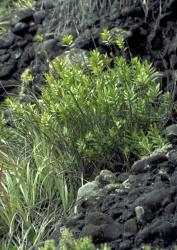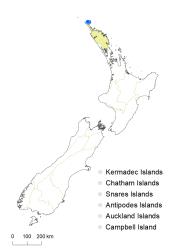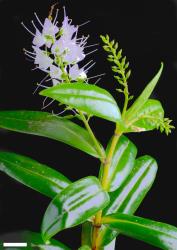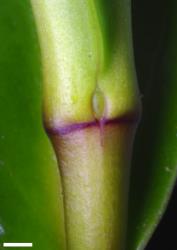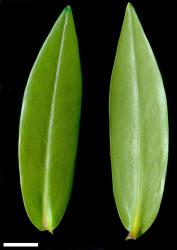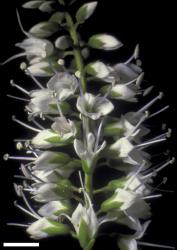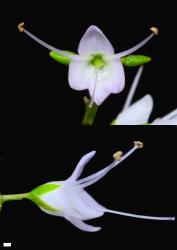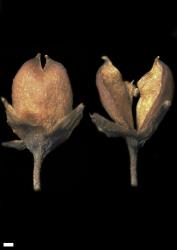- Taxon
- Gallery
- ≡ Hebe adamsii (Cheeseman) Cockayne & Allan, Trans. New Zealand Inst. 57: 15 (1926)
Low spreading or bushy shrub to 1 m tall. Stems ascending to erect, glabrous to minutely eglandular-puberulent; hairs bifarious to uniform. Leaf bud distinct, its leaves appressed at margins until fully grown; sinus elliptic, acute. Leaves opposite-decussate, erecto-patent to spreading; lamina coriaceous, lanceolate to broadly lanceolate or narrowly elliptic to elliptic, 15–85 mm long, 5–18 mm wide, glossy above, dull beneath, bronze-green to yellowish-green; midrib evident, secondary veins faint; surfaces glabrous or sometimes with minute eglandular hairs along midrib above, or rarely sparse sessile glandular hairs beneath; margin glabrous or sparsely ciliolate, entire; apex sub-acute to acute; base cuneate; petiole 1–2 mm long. Inflorescence a lateral raceme, 45–150 mm long; flowers crowded, 20–65, all bisexual; bracts alternate, linear, < or rarely = pedicels; pedicels erecto-patent to spreading, 2.5–6.0 mm long, minutely puberulent all around. Calyx lobes 4, acuminate or sometimes the posterior pair rounded, 2.5–4.0 mm long, sub-equal, glabrous or with sparse, minute sessile glands on faces; mixed glandular- and eglandular-ciliolate. Corolla 7–8 mm diameter; tube white, 2.3–4.0 mm long, slightly < to slightly > calyx, eglandular hairy inside; lobes 4, white to purplish, fading white, erect to erecto-patent, sub-equal, ovate or elliptic to deltoid, 3.5–5.5 mm long, sub-acute; nectar guides absent. Stamen filaments white to purplish, 6.0–9.5 mm long; anthers mauve to purple. Style glabrous, 4.0–8.5 mm long. Capsules latiseptate, sub-acute to obtuse, glabrous, 3.4–6.0 mm long, 2.8–4.0 mm at widest point. Seeds ellipsoid to discoid, flattened, smooth, pale brown to brown, 1.4–2.5 mm long.
The presence of a sinus in the leafy bud is distinctive among large-leaved hebes of the mainland of Northland, shared only with V. diosmifolia (characterised by smaller incised leaves and compound inflorescences) and V. speciosa (characterised by broad, fleshy leaves and robust red flowers).
Plants of V. adamsii could be mistaken for the similar V. perbella and V. saxicola; these all have large flowers with broad, acute or sub-acute corolla lobes. V. perbella and V. saxicola plants differ by having no sinus in the leaf bud, glabrous stems (rarely bifarious-puberulent in V. saxicola), and 2n = 40 chromosomes. Also, V. perbella capsules usually have a few short hairs along the septal groove and V. saxicola leaves are not glossy; both occur much further south than the known distribution range of V. adamsii.
adamsii | macrocarpa | perbella | saxicola | |
|---|---|---|---|---|
Stem hairs | uniformly to bifariously puberulent or glabrous | uniformly to bifariously puberulent | glabrous | usually glabrous or rarely bifarious-puberulent |
Leaf bud sinus | present | absent | absent | absent |
Lamina (above) | glossy | glossy | glossy | dull |
Calyx colour | dark green or bronze-green | yellow-green | pink, reddish, violet, or red- to brown-green | yellowish- to dark green |
Calyx lobes outer surface | minute sessile glands | glabrous or eglandular-puberulent | minute sessile glands | minute sessile glands |
Corolla colour | white to mauve, rarely violet | white, rarely lilac, sometimes tinged lilac or pink | violet-red, violet, pink, deep mauve, very rarely carmine | pale lavender (rarely lilac) |
Corolla tube | ≤ calyx; hairy inside | > calyx; hairy inside | ≤ calyx; hairy inside | < calyx; glabrous inside |
Corolla lobes | subacute | obtuse to rounded | acute | subacute or bluntly acute |
Capsule | glabrous | glabrous | glabrous except for a few short hairs along septal grooves | glabrous |
Distribution | far North, known only from four sites, all within 1 km2, west of Spirits Bay | southern Northland from Whangārei and southern Kaipara Harbour southwards to South Auckland, Coromandel, and near Kawhia | western Northland between Ahipara and Waima Forest | known only from Maungaraho Rock, near Dargaville |
North Island: Northland. Known only from Unuwhao Ridge, The Pinnacle, Pinnacle Ridge, and Tarure Hill, east of Spirits Bay.
East-facing breccia cliffs, usually among Astelia banksii or in vertical joints in the rock, sometimes in scrub. Recorded elevations range from 200 to 279 m.
Flowers: October–July; fruits: April–August and probably earlier.
2n = 80 (see Bayly & Kellow 2006, as Hebe adamsii).
Veronica adamsii is classified in V. subg. Pseudoveronica sect. Hebe and the informal group “Apertae” (large-leaved) (Albach & Meudt 2010; Bayly & Kellow 2006).
Plants from Tarure Hill have longer and wider leaves and longer, more robust inflorescences than plants in other populations (de Lange 1991, Garnock-Jones & Clarkson 1994). The Māori names koromiko, kōkōmuka, and variants – applied to V. stricta and V. salicifolia – might be applied also to similar large-leaved hebes, such as V. adamsii.



